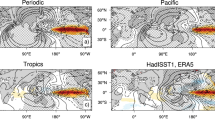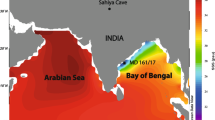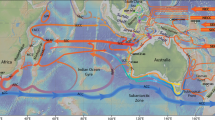Abstract
The recent decades-long decline in East African rainfall1 suggests that multidecadal variability is an important component of the climate of this vulnerable region. Prior work based on analysing the instrumental record implicates both Indian2 and Pacific1 ocean sea surface temperatures (SSTs) as possible drivers of East African multidecadal climate variability, but the short length of the instrumental record precludes a full elucidation of the underlying physical mechanisms. Here we show that on timescales beyond the decadal, the Indian Ocean drives East African rainfall variability by altering the local Walker circulation, whereas the influence of the Pacific Ocean is minimal. Our results, based on proxy indicators of relative moisture balance for the past millennium paired with long control simulations from coupled climate models, reveal that moist conditions in coastal East Africa are associated with cool SSTs (and related descending circulation) in the eastern Indian Ocean and ascending circulation over East Africa. The most prominent event identified in the proxy record—a coastal pluvial from 1680 to 1765—occurred when Indo-Pacific warm pool SSTs reached their minimum values of the past millennium. Taken together, the proxy and model evidence suggests that Indian Ocean SSTs are the primary influence on East African rainfall over multidecadal and perhaps longer timescales.
This is a preview of subscription content, access via your institution
Access options
Subscribe to this journal
Receive 51 print issues and online access
$199.00 per year
only $3.90 per issue
Buy this article
- Purchase on Springer Link
- Instant access to full article PDF
Prices may be subject to local taxes which are calculated during checkout




Similar content being viewed by others
References
Lyon, B. & DeWitt, D. A recent and abrupt decline in the East African long rains. Geophys. Res. Lett. 39, L02702 (2012)
Williams, A. & Funk, C. A westward extension of the warm pool leads to a westward extension of the Walker circulation, drying eastern Africa. Clim. Dyn. 37, 2417–2435 (2011)
Famine Early Warning System Network. East Africa: past year one of the driest on record in the eastern Horn. http://www.fews.net/docs/Publications/FEWSNETEA_Historicaldroughtcontext_061411.pdf (2011)
Nicholson, S. & Entekhabi, D. The quasi-periodic behavior of rainfall variability in Africa and its relationship to the Southern Oscillation. Meteorol. Atmos. Phys. 34, 311–348 (1986)
Ropelewski, C. & Halpert, M. Global and regional scale precipitation patterns associated with the El Niño/Southern Oscillation. Mon. Weath. Rev. 115, 1606–1626 (1987)
Funk, C. et al. Warming of the Indian Ocean threatens eastern and southern African food security but could be mitigated by agricultural development. Proc. Natl Acad. Sci. USA 105, 11081–11086 (2008)
Verschuren, D. in Past Climate Variability Through Europe and Africa (eds Battarbee, R. W., Gasse, F. & Stickley, C. E. ) 219–256 (Springer, 2004)
Anchukaitis, K. J. & Tierney, J. E. Identifying coherent spatiotemporal modes in time-uncertain proxy paleoclimate records. Clim. Dyn. advance online publication, http://dx.doi.org/10.1007/s00382-012-1483-0 (26 August 2012)
Verschuren, D., Laird, K. R. & Cumming, B. F. Rainfall and drought in equatorial East Africa during the past 1,100 years. Nature 403, 410–414 (2000)
Russell, J. M. & Johnson, T. C. Little Ice Age drought in equatorial Africa: Intertropical Convergence Zone migrations and El Niño-Southern Oscillation variability. Geology 35, 21–24 (2007)
Dommenget, D. & Latif, M. A cautionary note on the interpretation of EOFs. J. Clim. 15, 216–225 (2002)
Ummenhofer, C. C., Gupta, A. S., England, M. H. & Reason, C. J. C. Contributions of Indian Ocean sea surface temperatures to enhanced East African rainfall. J. Clim. 22, 993–1013 (2009)
Gent, P. et al. The community climate system model version 4. J. Clim. 24, 4973–4991 (2011)
Delworth, T. et al. GFDL’s CM2 global coupled climate models. Part I: formulation and simulation characteristics. J. Clim. 19, 643–674 (2006)
Wittenberg, A. Are historical records sufficient to constrain ENSO simulations? Geophys. Res. Lett. 36, L12702 (2009)
Black, E., Slingo, J. & Sperber, K. R. An observational study of the relationship between excessively strong short rains in coastal East Africa and Indian Ocean SST. Mon. Weath. Rev. 131, 74–94 (2003)
Oppo, D. W., Rosenthal, Y. & Linsley, B. K. 2,000-year-long temperature and hydrology reconstructions from the Indo-Pacific warm pool. Nature 460, 1113–1116 (2009)
Jansen, E. J. et al. in Climate Change 2007: The Physical Science Basis (eds Solomon, S. et al.) 433–498 (Cambridge Univ. Press, 2007)
Christensen, J. H. et al. in Climate Change 2007: The Physical Science Basis (eds Solomon, S. et al.) 847–940 (Cambridge Univ. Press, 2007)
Verschuren, D. et al. Half-precessional dynamics of monsoon rainfall near the East African equator. Nature 462, 637–641 (2009)
Tierney, J. E., Russell, J. M., Sinninghe Damsté, J. S., Huang, Y. & Verschuren, D. Late Quaternary behavior of the East African monsoon and the importance of the Congo Air Boundary. Quat. Sci. Rev. 30, 798–807 (2011)
Wolff, C. et al. Reduced interannual rainfall variability in East Africa during the last ice age. Science 333, 743–747 (2011)
Stager, J. C., Ryves, D. B., Cumming, B. F., Meeker, L. D. & Beer, J. Solar variability and the levels of Lake Victoria, East Africa, during the last millenium. J. Paleolimnol. 33, 243–251 (2005)
Tierney, J. et al. Late-twentieth-century warming in Lake Tanganyika unprecedented since ad 500. Nature Geosci. 3, 422–425 (2010)
Garcin, Y. et al. Centennial to millennial changes in maar-lake deposition during the last 45,000 years in tropical Southern Africa (Lake Masoko, Tanzania). Palaeogeogr. Palaeoclimatol. Palaeoecol. 239, 334–354 (2006)
Garcin, Y. et al. Solar and anthropogenic imprints on Lake Masoko (southern Tanzania) during the last 500 years. J. Paleolimnol. 37, 475–490 (2007)
Brown, E. T. & Johnson, T. C. Coherence between tropical East African and South American records of the Little Ice Age. Geochem. Geophys. Geosyst. 6, Q12005 (2005)
Johnson, T. & McCave, I. Transport mechanism and paleoclimatic significance of terrigenous silt deposited in varved sediments of an African rift lake. Limnol. Oceanogr. 53, 1622–1632 (2008)
Rudolf, B., Becker, A., Schneider, U., Meyer-Christoffer, A. & Ziese, M. GPCC status report, December 2011. http://www.dwd.de/bvbw/generator/DWDWWW/Content/Oeffentlichkeit/KU/KU4/KU42/en/Reports__Publications/GPCC__status__report__2010,templateId=raw,property=publicationFile.pdf/GPCC_status_report_2010.pdf (2011)
Acknowledgements
J.E.T. acknowledges the US NOAA Climate and Global Change Postdoctoral Fellowship and NSF OCE-1203892 for support. J.E.S. and R.S. were supported by the NOAA award Global Decadal Hydroclimate Variability and Change (NA10OAR431037). We thank the National Center for Atmospheric Research, who made the CCSM4 control simulation available through the US Earth System Grid (ESG) Center. Support for the ESG is provided by the Office of Science, US Department of Energy, with co-sponsorship from the US NSF. Thanks also to NOAA GFDL for providing the multimillennial control simulation output from the GFDL CM2.1 model, to N. Naik for her on-site support at LDEO and to J. Jungclaus of the Max Planck Institute for providing output from the MPI COSMOS control simulation. This is LDEO contribution number 7641.
Author information
Authors and Affiliations
Contributions
J.E.T. designed the study and interpreted the palaeoclimate results. J.E.S. provided the climate modelling results. K.J.A. and J.E.T. designed and implemented the MCEOF method. J.E.S. and R.S. interpreted the dynamical implications of the climate model output. All authors collaborated on the synthesis of the proxy and model data and the writing of the manuscript.
Corresponding author
Ethics declarations
Competing interests
The authors declare no competing financial interests.
Supplementary information
Supplementary Information
This file contains Supplementary Text 1-4, Supplementary References, Supplementary Tables 1- 2, and Supplementary Figures 1-6. (PDF 3796 kb)
Supplementary Data
This file contains the proxy data used in the East African synthesis. It includes the associated chronological information and the MCEOF1 time series and spatial loadings. (XLS 325 kb)
Rights and permissions
About this article
Cite this article
Tierney, J., Smerdon, J., Anchukaitis, K. et al. Multidecadal variability in East African hydroclimate controlled by the Indian Ocean. Nature 493, 389–392 (2013). https://doi.org/10.1038/nature11785
Received:
Accepted:
Published:
Issue Date:
DOI: https://doi.org/10.1038/nature11785
This article is cited by
-
Zonal control on Holocene precipitation in northwestern Madagascar based on a stalagmite from Anjohibe
Scientific Reports (2024)
-
Reversed Holocene temperature–moisture relationship in the Horn of Africa
Nature (2023)
-
Abrupt change in tropical Pacific climate mean state during the Little Ice Age
Communications Earth & Environment (2023)
-
Potential impacts of 1.5 °C and 2 °C global warming levels on drought modes over Eastern Africa
Climatic Change (2023)
-
Terrestrial versus aquatic source identification of sedimentary n-alkane and sugar biomarkers: a case study from the Bale Mountains, Ethiopia
Journal of Paleolimnology (2023)
Comments
By submitting a comment you agree to abide by our Terms and Community Guidelines. If you find something abusive or that does not comply with our terms or guidelines please flag it as inappropriate.



